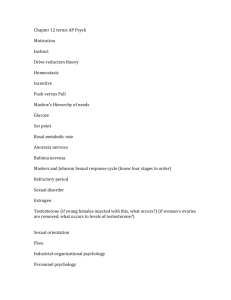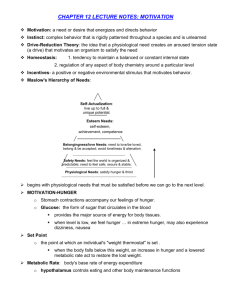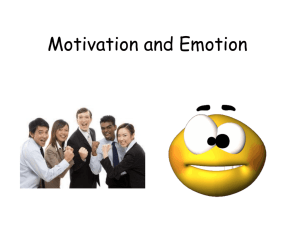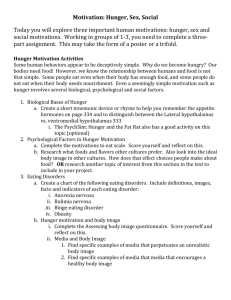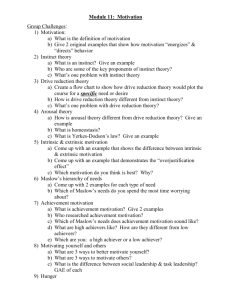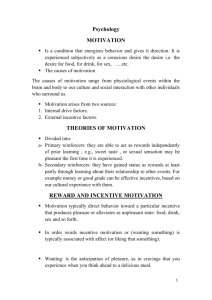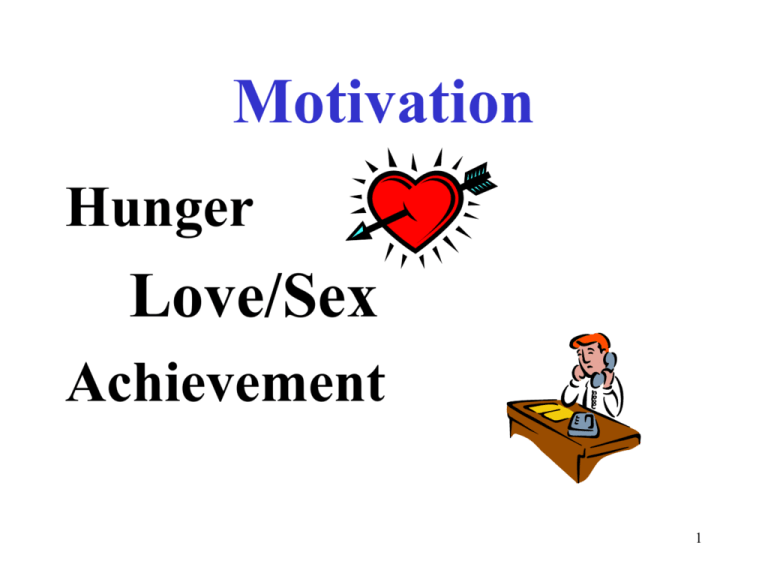
Motivation
Hunger
Love/Sex
Achievement
1
Instinct
• A complex behavior that is rigidly patterned
throughout a species and is unlearned.
• Examples:
– Imprinting in birds
– The return of the salmon to their birthplace
– Innate tendencies in humans such as rooting
and sucking
3
(1) Drive Reduction Theory
• A physiological need creates an aroused
tension state (a drive) that motivates an
organism to satisfy the need.
Physiological Need
Psychological Need
4
• Inner Pushes
• External Pulls
We are pushed by our
need to eat (hunger) to
reduce the tension by
eating.
The physiological aim of
drive reduction is
homeostasis
We are pulled by
incentives – positive
or negative stimuli that
lure or repel us.
Examples:
The sight of an attractive
person
The threat of disapproval
5
(2) Arousal
• Some motivated behavior increases arousal.
• Well-fed animals will leave their shelter to
explore, seemingly in the absence of any
need-based drive.
• Curiosity drives explorers and scientists to
discover.
6
Abraham
Maslow
Hierarchy
of
Needs
7
Hierarchy of Needs
8
Hunger
The Physiology of Hunger
1- Body Chemistry (insulin and
glucose)
2- The Brain (hypothalamus)
3- Set Point
4- Basal Metabolic Rate
9
The
Endocrine
System
10
The Endocrine System
The Hypothalamus
It is involved with drives associated with
survival such as hunger, thirst, emotion,
sex, and reproduction
11
The Brain
The Hypothalamus
The Lateral
Hypothalamus
(brings on hunger)
When deprived of food
and blood sugar is low,
the LH churns out
orexin, a hungertriggering hormone.
The Ventromedial
Hypothalamus
(depresses hunger)
Stimulate this area and an
animal will stop eating.
Destroy it & the animal’s
intestines will process
food very rapidly
causing it to eat more
12
often.
How Does these Complementary
Areas in the Hypothalamus Work?
1- They influence how much glucose is converted
to fat and how much is left available to fuel
immediate activity (and minimize hunger).
2- Distributed brain systems monitor the body’s
state and reports to the hypothalamus, which
sends the information to the frontal lobes,
which decide behavior.
13
How Does these Complementary
Areas in the Hypothalamus Work?
3- Manipulating the lateral and
ventromedial hypothalamus alters the
body’s “weight thermostat”, which
predisposes us to keep our body at a
particular weight level called “set point.”
14
Maintaining the Body’s Set-Point
Weight
1- The body adjusts to food intake.
2- The body adjusts to energy output
3- The body adjusts to its basal metabolic rate
15
Basal Metabolic Rate
• The rate at which the body burns calories
for energy depending on:
• 1- fat cells
• 2- hormones
• 3- metabolism
16
Hunger
The Psychology of Hunger
1- External Incentives
2- Taste Preferences
Genetic
Conditioned
17
Eating Disorders
Obesity
Anorexia Nervosa
Bulimia
18
What Causes Eating Disorders?
Early Maturity
Depression
Genes
Problems
The Desire to Fit the Social Ideal of Slender
Culture
19
Obesity
The Physiology of Obesity
1- Fat Cells
2- Set-Points and Metabolism
3- The Genetic Factor
4- Losing Weight
20
Genes and Weight
• Set-Point Theory
• A biological mechanism keeps a person’s
body weight at a genetically influenced
set-point – the weight you stay at when
you are not consciously trying to gain or
lose weight.
21
The “Obese” Gene
• Obese gene causes fat cells to produce
leptin.
• Leptin travels through blood to
hypothalamus (regulates appetite)
• Leptin reduces appetite
22
Why Do People Gain Weight
Rapidly?
• Secretion of leptin is impaired
• May produce plenty of leptin but
their body does not respond to it.
• Tendency to store calories which
have a survival advantage.
23
Losing Weight
1- Minimize exposure to tempting food cues.
2- Take steps to boost your metabolism.
3- Be realistic and moderate.
4- Modify both your metabolic rate and your hunger
by changing what you eat.
5-Don’t starve all day and eat one big meal at night.
6- Beware of the binge
7- Begin only if you are prepared to exercise and
restrict your eating permanently.
24
Discuss
1-Discuss your own basal metabolic rate and set
point. How do they affect your weight?
2-Are you an external or an internal when it comes
to hunger?
3-Discuss your taste preferences. Are they genetic,
cultural, or conditioned?
4-Can you change your set point? How?
5-How does leptin work?
6-What is the role of the frontal lobes when it comes
to hunger and eating habits?
7-How do we become fat? Discuss the role of leptin,
the set point, your taste preferences, fat cells.
25
Discuss
instinct, drive-reduction theory,
Incentive, homeostasis, set-point,
hierarchy of needs, externals, basal
metabolic rate, internals, hungerregulating chemicals, orexin, lateral
hypothalamus, leptin, ventromedial
hypothalamus
26
Motives for Love
• Need for Affiliation
The need to associate with others, as by seeking
friends, companionship, and love
• Need for Attachment
The deep emotional tie to, and sense of almost
physical connection with a loved one
• Need for Contact Comfort
The pleasure derived from close physical
contact
27
Contact Comfort
Margaret & Harry Harlow
• The Rhesus Experiment
Two Kinds of Surrogate Mothers:
1-One made of wires and warming
lights,with a milk bottle connected to it
2-One was made of wire and covered with
foam rubber and cuddly terry cloth
Which mother did the rhesus monkeys
chose?
28
29
Separation Anxiety
• The distress that most children
develop, at around 7-9 months of
age, when their primary
caregivers temporarily leave
them with strangers or in a new
environment
30
Separation Anxiety
Mary Ainsworth
• The Strange Situation Experiment
Three Categories of Children
1-Securely attached
2-Avoidant
3-Anxious-ambivalent
31
Styles of Attachment
Insecure
Attachment
Avoidant
AnxiousAmbivalent
Secure
Attachment
Securely
Attached
32
Three Categories of Children
Securely Attached
They cry if the parent leaves the room; they welcome
her back and then play happily again.
Avoidant
They don’t care if the mother leaves the room and
make a little effort to seek contact with her on her
return.
Anxious-Ambivalent
They protest loudly when the mother leaves, yet
resist contact with her when she comes back.
33
Attachment Styles in Adults
Philip Shaver
• Secure Attachment style
• Avoidant Attachment Style
• Anxious-ambivalent Style
34
Sternberg’s Triangular
Theory of Love
• The Intimacy Component
• The Passion Component
• The Decision/Commitment
Component
35
36
Sternberg’s Triangular Theory
(8 Combinations of Love)
Nonlove
Liking
Infatuate
Empty
Romantic
Companionate
Fatuous
Consommate
Intimacy Passion
+
+
+
+
+
+
+
+
Commitment
+
+
+
+
37
The Six Styles of Love
John Alan Lee
•
•
•
•
•
1-Eros (romantic, passionate love)
2-Ludus (game-playing love)
3-Storge (affectionate, friendly love)
4-Pragma (logical, pragmatic love)
5-Mania (possessive, dependent, “crazy”
love)
• 6-Agape (unselfish love)
38
What Determines
Compatibility
• Homagamy
The tendency to marry someone who is similar in
age, race, education, and other characteristics.
• The Marriage Gradient
The tendency to marry women who are
slightly younger, smaller and lower in
status, and women to marry men who are slightly
older, larger and higher in status.
39
Motives for Sex
• 1-The Biology of Desire
• 2-The Psychology of Desire
• 3-The Culture of Desire
40
The Biology of Desire
• The Sexual Response Cycle
Masters and Johnson (1966)
1- Excitement Phase
2- Plateau Phase
3- Orgasm
4- Resolution Phase (refractory period)
41
The Biology of Desire
• Sex Hormones
• Testosterone contributes to sexual
arousal.
• Sexual activity contributes to the
production of testosterone.
• At ovulation, women’s sexual desire is
only slightly higher than at other times.
42
The Psychology of Desire
•
•
•
•
•
•
•
The Brain is the sexiest organ
Motives for Sex
External Stimuli
Enhancement
Intimacy
Imagined Stimuli
Coping
Self-affirmation
Partner approval
Peer approval
43
Sexual Orientation
• In Europe and the US 3 or 4 percent of men
are homosexual.
• 1 or 2 percent of women are homosexual.
• Fewer than 1% are bisexual.
44
Sexual Orientation
Five Theories
Biological
Genetic
Learning
Prenatal
Brain
Psychoanalytic
Freud
Interactionist
Sociological
Bieber
45
Brain and Sexual Orientation
• Simon LeVay
• A cell cluster was reliably larger in
heterosexual men than in women and
homosexual men.
• The critical question is:
– When did the brain difference begin?
– Everything psychological is simultaneously
biological
46
Genes and Sexual Orientation
• Research on Homosexual Twin Brothers
• Among their identical twin brothers, 52%
were homosexual.
• Among the fraternal twin brothers, 22%
were homosexual.
47
Genes and Sexual Orientation
• A Follow-up Study on Homosexual Women
Twin Sisters
• 48% of their identical twins were homosexual.
• 16% of their fraternal twins were homosexual
• With half the identical twin pairs differing, we
know that genes are not the whole story
• This is the sort of pattern we expect to see when
genes are having an influence.
48
Prenatal Hormones and Sexual
Orientation
• Stress on mother during pregnancy reduces
testoterone which is thought to cause
homosexuality in men.
• Exposure to abnormally high levels of estrogen
may produce female offspring who are more
likely to be lesbian.
• The birth order male brothers
49
Sexual Orientation
• 1-Genetic and biological factors
• 2-Family, peers, and environmental factors
• 3-Complex interplay of genetic,
physiological, and environmental factors
50
The Culture of Desire
• Attitudes and sexual behaviors vary across
the planet.
• Attitudes and sexual behaviors vary with
time within the same culture.
51
Why Don’t Teens Use
Contraceptives?
1- Ignorance
2- Guilt related to sexual activity
3- Minimal communication about birth
control
4- Alcohol use
5- Mass media norms of unprotected
promiscuity
52
Is Sexual Orientation Genetic or
Learned?
Consider:
1- Simon LeVay research
2- Research on male identical and fraternal
twins
3- Research on female identical and fraternal
twins.
4- The effect of prenatal hormones
53
Motives for Achievement
•
•
•
•
•
•
•
•
Satisfaction on the job
The job itself
Variety
Influence over others
Supportive relationships
Useful feedback
Opportunities offered
Clear and consistent rules
54
Holland’s Personality Type
Theory
Realistic
Farmers, laborers, truck drivers
Intellectual
Careers in math and science
Social
Salesmen, teachers, counselors
Conventional
Clerks, secretaries, bank tellers
Enterprising
Managers, politicians,
Artistic
Occupations involving arts
55
56
Why Do People Work?
• 1-Extrinsic Rewards
• 2-Intrinsic Rewards
• 3-Personal Identity
• 4-Social Lives
• 5-Status
57
Sources of Achievement
Motivation
• Emotional Roots
– They associate achievement with positive
emotions.
• Cognitive Roots
– They attribute achievement to their own
competence and effort.
58
Motivating People
•
•
•
•
Cultivate Intrinsic Motivation
Attend to People’s Motives
Set Specific, Challenging Goals
Choose an Appropriate Leadership Style.
59

